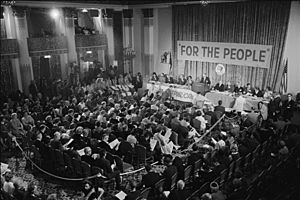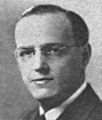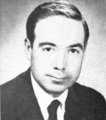1964 Republican National Convention facts for kids
| 1964 presidential election |
|
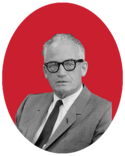 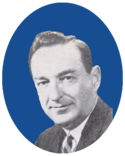
Nominees
Goldwater and Miller |
|
| Convention | |
|---|---|
| Date(s) | July 13–16, 1964 |
| City | Daly City, California |
| Venue | Cow Palace |
| Chair | Thruston Ballard Morton |
| Notable speakers | Richard M. Nixon Nelson Rockefeller |
| Candidates | |
| Presidential nominee | Barry Goldwater of Arizona |
| Vice presidential nominee | William E. Miller of New York |
| Other candidates | Nelson Rockefeller William Scranton |
| Voting | |
| Total delegates | 1,308 |
| Votes needed for nomination | 655 |
| Results (president) | Goldwater (AZ): 883 (67.50%) Scranton (PA): 214 (16.36%) Rockefeller (NY): 114 (8.72%) |
| Results (vice president) | Miller (NY): 100% (Roll call) |
| Ballots | 1 |
The 1964 Republican National Convention was a big meeting where the Republican Party chose its candidates for president and vice president. It happened in the Cow Palace in Daly City, California, from July 13 to July 16, 1964. This was only the second time a Republican convention was held on the West Coast. Many people thought this showed that the Republican Party was becoming stronger in the western parts of the United States.
Contents
Who Ran for President?
The 1964 Republican primaries were like a competition to see who would be the party's presidential candidate. The two main candidates were Nelson Rockefeller from New York, who was seen as more liberal, and Barry Goldwater from Arizona, who was more conservative.
Right before the important California primary election, something happened in Rockefeller's family life that made some conservatives less likely to support him. This helped Goldwater win the primary. Even though some people tried to get William Scranton, the Governor of Pennsylvania, nominated instead, it didn't work. By the end of the primaries, Goldwater had enough support to become the nominee.
It's important to know that Margaret Chase Smith, a Senator, also had her name put forward for nomination at this convention. This was a historic moment because it was the first time a woman's name was officially entered for president at a major political party's convention.
What Happened at the Convention?
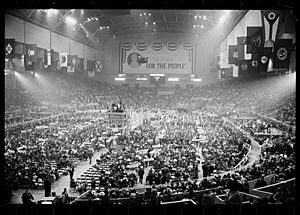
The 1964 Republican Convention was full of excitement and disagreements. Goldwater's conservative supporters and Rockefeller's more moderate supporters often clashed. Goldwater was known as the main voice for conservatives. This meant he wasn't as popular with the moderate and liberal members of the Republican Party.
When Rockefeller tried to give a speech, some conservative delegates booed him. They saw him as part of the "eastern liberal establishment." Even with all the disagreements, Goldwater easily won the nomination. He chose William E. Miller, a Representative from New York, to be his running mate for vice president.
In his speech accepting the nomination, Goldwater talked about Communism as a big problem in the world. He also said, "I would remind you that extremism in the defense of liberty is no vice. And let me remind you also that moderation in the pursuit of justice is no virtue." Some people, even those on his own team, thought these words might make it harder for him to win the election. They felt he was pushing away the moderate and liberal voters in his party.
Richard Nixon, who was a former vice president and would later become president, introduced Goldwater. He called him "Mr. Conservative" and "Mr. Republican." Nixon said Goldwater would be "Mr. President." This was the only Republican convention between 1952 and 1972 where Nixon wasn't nominated for president or vice president himself.
During the celebrations, some Republican officials tried to remove reporters from the convention floor. A reporter named John Chancellor refused to leave. Police officers escorted him out, and he famously said on air, "This is John Chancellor, somewhere in custody!" Another journalist, Belva Davis, reported that she and another Black reporter were chased out by attendees yelling mean things.
The main meeting place for the convention was the newly opened San Francisco Hilton hotel.
What Was the Party's Plan?
The 1964 Republican Party's platform, which is like a list of what the party believes and plans to do, was mostly shaped by Goldwater's conservative ideas. It called for:
- Less government involvement in people's lives.
- Criticism of the foreign and domestic policies of Presidents John F. Kennedy and Lyndon B. Johnson.
- More freedom for businesses and the economy.
- A strong stance against Communism in North Vietnam.
- Changes to the United Nations.
- Strong support for NATO.
- Lower taxes.
- A tough approach to international Communism.
- An accusation that the Kennedy Administration was too soft on the Soviet Union.
Who Else Ran for President?
Here are some of the other people who were considered for the Republican presidential nomination in 1964:
-
Former Representative
Walter Judd
from Minnesota -
Ambassador
Henry Cabot Lodge, Jr.
of Massachusetts -
Former Governor
Harold Stassen
of Minnesota
How Were the Votes Counted?
The delegates at the convention voted for their preferred candidate. Here's how the votes for president turned out:
- Barry Goldwater: 883 votes
- William Scranton: 214 votes
- Nelson Rockefeller: 114 votes
- George Romney: 41 votes
- Margaret Chase Smith: 27 votes
- Walter Judd: 22 votes
- Hiram Fong: 5 votes
- Henry Cabot Lodge, Jr.: 2 votes
Who Was the Vice Presidential Nominee?
William E. Miller, a Representative from New York, was chosen unanimously as the vice presidential candidate. He had been the chairman of the Republican National Committee since 1961. Goldwater said he picked Miller because he thought Miller would annoy President Johnson. However, some people believed Johnson barely knew who Miller was.
Miller's background from the Eastern U.S. and his Catholic faith helped balance the ticket in some ways, even though he was also a conservative like Goldwater. He wasn't very well-known, which led to a popular question at the time: "Here's a riddle, it's a killer / Who the hell is William Miller?"
After the convention, Dean Burch, a strong supporter of Goldwater from Arizona, took over as the chairman of the Republican National Committee.
See also
- History of the United States Republican Party
- List of Republican National Conventions
- U.S. presidential nomination convention
- 1964 Democratic National Convention
- 1964 United States presidential election
- Barry Goldwater presidential campaign, 1964


